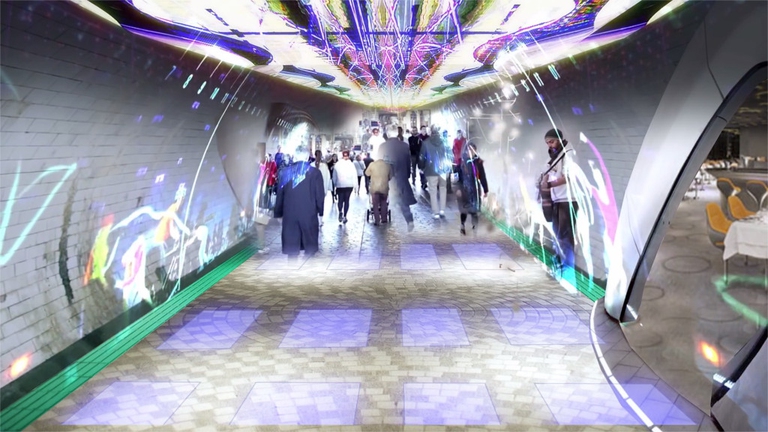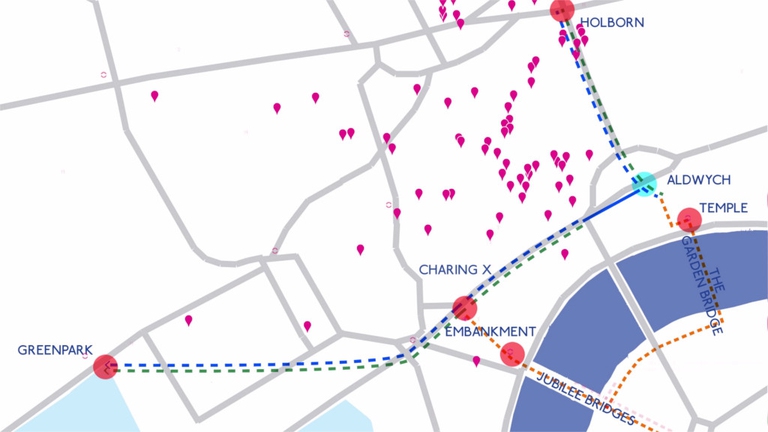
Milan has announced one of Europe’s most ambitious mobility schemes, known as Strade Aperte (open roads). Its goal is to reduce cars in phase 2 of the lockdown by increasing bike lanes and pedestrian areas.
An ambitious project will transform London’s disused tunnels into cycling and pedestrian paths with shops, cultural spaces and floors that generate their own energy.
London’s dormant tube tunnels will be transformed into cycling and pedestrian paths, retail and cultural spaces. This is what the London Underline project, which was given the 2015 London Planning Award, envisages.
The London Underline is a project realised by a team of architects at Gensler aimed at reusing and redeveloping existing tube tunnels in order to connect some of the neighbourhoods of the UK’s capital. The architects planned to turn disused tunnels and stations into areas where to take a break as well as ride a bike.
The current project will connect two pairs of tunnels extending 2.4 kilometres from Holborn to Green Park. The former runs from Green Park to Aldwych, the latter from Aldwich to Holborn. This stretch, which connected the two stations, was abandoned in the ‘80s, while the tunnel that runs from Holborn to Green Park was part of the Jubilee Line, abandoned in the ‘90s.
But that’s not all. London’s underground paths will also be eco-friendly. In fact, the idea was to generate renewable energy thanks to the people who will pass through the tunnel: the Pavegen start-up company will pave the tunnels with panels that harness the kinetic energy of pedestrian footfall to generate energy, an excellent way to lit up the galleries.
London is a cosmopolitan megalopolis of more than 1,500 square kilometres and with 8 and a half million inhabitants. Such a big city must know how to manage important issues including urbanization and mobility.
As regards bike infrastructures, conservative mayor Boris Johnson welcomed other important projects such as the superhighways and CycleSky, an elevated network of bike routes to let cyclists avoid car traffic. And now there’s someone who thought of building the future of cycling lanes underground.
Siamo anche su WhatsApp. Segui il canale ufficiale LifeGate per restare aggiornata, aggiornato sulle ultime notizie e sulle nostre attività.
![]()
Quest'opera è distribuita con Licenza Creative Commons Attribuzione - Non commerciale - Non opere derivate 4.0 Internazionale.
Milan has announced one of Europe’s most ambitious mobility schemes, known as Strade Aperte (open roads). Its goal is to reduce cars in phase 2 of the lockdown by increasing bike lanes and pedestrian areas.
Formula 1, the world’s most important auto racing championship, has decided to turn the page and aim for carbon neutrality with the support of its teams, drivers and the whole racing circus.
A trip by bike from Amsterdam to London with two cats in tow. Obviously, the four-legged travel companions didn’t run after their master Thomas, but they were on board of a peculiar cargo bike. They travelled many cities, drawing the attention of young and old passengers, due to Mushi’s and Cheesy’s big eyes looking around.
Toyota and LifeGate began telling the story of hybrid mobility back in 2006, now, on the road to the Tokyo 2020 Olympics, they’re still treading the path of sustainable mobility. Here are the main steps of the journey.
Germany’s first solar bicycle lane could be the prototype for the roads of the future. The photovoltaic tiles melt snow and ice, and are capable of absorbing noise.
The Vespa is back in an electric version. Production has just started and the first models can be reserved online starting from October.
The city of Utrecht, in the Netherlands, is home to a bridge for cycling and walking that stretches over roof garden of a Montessori school. This project enhances practicality and will allow families to bring children to school by bike, passing through green areas. Despite their functionality, bridges are often seen as an infrastructure that is
The Lego hair bike helmet is the latest Internet craze. For now it’s just a prototype but production on a large scale will probably start soon.
Just as fires often give way to new growth, after the Dieselgate scandal, which saw Volkswagen cheating on US emission rules, the German car manufacturer radically changed course, beginning to focus on sustainable mobility. The German car company aims to propose thirty zero-emission models and produce at least one million battery electric vehicles by 2025. An ambitious mission









